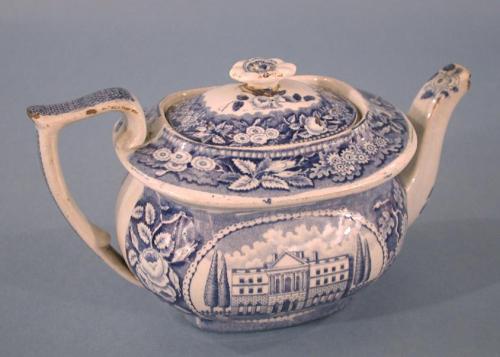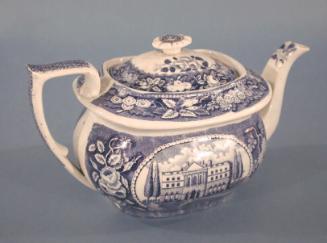Teapots
MakerAttributed to
Andrew Stevenson
(English, 1816 - 1830)
Date1816-1830
MediumMold-formed buff-colored earthenware with a blue-tinted glaze and underglaze cobalt blue decoration
DimensionsPrimary Dimensions (height x width x depth of .3a): 5 1/2 x 10 x 5 1/2in. (14 x 25.4 x 14cm)
Primary Dimensions (height including lid x width x depth of .4a,b): 5 3/4 x 10 x 5in. (14.6 x 25.4 x 12.7cm)
Primary Dimensions (height including lid x width x depth of .5a-c): 5 1/4 x 9 7/8 x 5 1/4in. (13.3 x 25.1 x 13.3cm)
Primary Dimensions (height including lid x width x depth of .6a,b): 5 3/4 x 9 7/8 x 5 1/4in. (14.6 x 25.1 x 13.3cm)
Primary Dimensions (height including lid x width x depth of .7a,b): 5 1/4 x 8 7/8 x 4 7/8in. (13.3 x 22.5 x 12.4cm)
ClassificationsCeramics
Credit LineGift of Mrs. Morgan B. Brainard, Jr.
Object number1978.102.3-.7a,b
DescriptionGroup of five rectangular teapots of buff-colored earthenware with a blue-tinted glaze, a type of ceramic known as pearlware. Each teapot sits on a rectangular foot and has swelled sides that narrow and then flare again just below the rim. A molded spout and handle have been applied on opposite sides of each teapot, just on top of two mold lines in the ceramic. The teapots are decorated with a transfer-printed underglaze cobalt blue pattern titled, "State House Hartford" on the bottom. The pattern shows a neoclassical, or Federal style, building. The building sits on a tall, stone first floor, with two brick storeys above it. The structure has a projecting portico with six columns, a balustrade, and four chimneys emerging from the roof. There are two tall trees on either side of the building and a fence in the background. A man with a cane or walking stick is standing on the lawn in front of the building. The pattern is printed twice on opposite sides of each teapot. Each pattern is surrounded by a circular border of white geometric shapes, then various flowers and leaves on a blue field. A border is printed at the rim of each teapot, and consists of various flowers and leaves on a blue field. Each spout is decorated with printed white flowers and blue leaves, while each handle is decorated with multiple rows of small blue dots surrounded by blue circles.
Most of the teapots (only excluding .3) have a lid which is decorated at the rim with a border of various flowers and leaves on a blue field. Additional small flowers are printed on the lids as well, and there is a small hole in the ceramic just to the left of the finial. Each oval finial on the lid is shaped like a flower and is printed with a circular blue design.
While the seven teapots have the same general description they are of slightly different sizes. Additionally, the teapots each have their own condition problems.
Teapot (.3a): The handle, portions of the rim, and the tip of the spout have been rebuilt using a now yellowing conservation material. At one time the entire foot of the teapot broke off and was reattached. The lid is missing and the teapot is generally dirty.
Teapot (.4a,b): The tip, a portion of the inside edge of the rim, and a corner of the lid have been repaired using a now yellowing conservation material. This same material was used to entirely replace the finial on the lid as well. There is crazing on the inside surface of the teapot.
Teapot (.5a,b,c): There are a series of severe cracks that begin at the bottom of the teapot and run up the sides. A corner and the top of the lid have been repaired using a now yellowing conservation material. Additionally, the rebuilt finial of the lid (.c) broke off at some time after being repaired, and is now stored in a plastic container inside the teapot.
Teapot (.6a,b): The entire handle on the teapot has been rebuilt using a now-yellowing conservation material. The tip of the spout has been repaired as well. At one time the lid broke into several pieces; these were repaired using metal staples. The remnants of a newspaper or typed label are adhered to the bottom of teapot .6a.
Teapot (.7a,b): There is crazing over all the surfaces of the teapot, and a few chips missing from the top of the handle on the teapot. The tip of the spout is missing. There are three chips in the rim of the lid.
NotesSubject Note: The Connecticut State House was designed by Charles Bulfinch of Boston, and built by Jeremiah Halsey of Preston, Connecticut, and Andrew Ward of Guilford, Connecticut. The first session of the General Assembly was held in the State House on 11 May 1796. In 1878, the State House was turned over for use as a City Hall. In 1915, the Old State House was abandoned, and used intermittently for various non-governmental purposes. Several restoration projects took place over the following years, and in 1961, the Old State House was designated a National Historic Landmark. (Hunt 11/4/2004)Most of the teapots (only excluding .3) have a lid which is decorated at the rim with a border of various flowers and leaves on a blue field. Additional small flowers are printed on the lids as well, and there is a small hole in the ceramic just to the left of the finial. Each oval finial on the lid is shaped like a flower and is printed with a circular blue design.
While the seven teapots have the same general description they are of slightly different sizes. Additionally, the teapots each have their own condition problems.
Teapot (.3a): The handle, portions of the rim, and the tip of the spout have been rebuilt using a now yellowing conservation material. At one time the entire foot of the teapot broke off and was reattached. The lid is missing and the teapot is generally dirty.
Teapot (.4a,b): The tip, a portion of the inside edge of the rim, and a corner of the lid have been repaired using a now yellowing conservation material. This same material was used to entirely replace the finial on the lid as well. There is crazing on the inside surface of the teapot.
Teapot (.5a,b,c): There are a series of severe cracks that begin at the bottom of the teapot and run up the sides. A corner and the top of the lid have been repaired using a now yellowing conservation material. Additionally, the rebuilt finial of the lid (.c) broke off at some time after being repaired, and is now stored in a plastic container inside the teapot.
Teapot (.6a,b): The entire handle on the teapot has been rebuilt using a now-yellowing conservation material. The tip of the spout has been repaired as well. At one time the lid broke into several pieces; these were repaired using metal staples. The remnants of a newspaper or typed label are adhered to the bottom of teapot .6a.
Teapot (.7a,b): There is crazing over all the surfaces of the teapot, and a few chips missing from the top of the handle on the teapot. The tip of the spout is missing. There are three chips in the rim of the lid.
Status
Not on view











